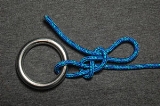
Siberian hitch
Encyclopedia
Siberian Hitch is a knot
used to attach a rope
to an object. The hitch is thought to have originated from the Evenk people of Siberia
. It is a quick release hitch often used by Ray Mears during his bushcraft
television series. The hitch is known for the ease in which it can be tied even whilst wearing gloves or mittens in cold climates. This hitch is also slipped and therefore can be released by pulling the short end of the rope.
It consists basically of three loops. The first is made by looping the rope around the object to which it is to be attached (leaving enough length of rope at the end). In the end is then made a loop, which is given a half twist and bent around the main rope. The remaining end is then looped again and bent around the other side of the main rope and inserted into the previous loop. This is a structural description. There are also 'shortcuts' to this, as shown in the external link.
Knot
A knot is a method of fastening or securing linear material such as rope by tying or interweaving. It may consist of a length of one or several segments of rope, string, webbing, twine, strap, or even chain interwoven such that the line can bind to itself or to some other object—the "load"...
used to attach a rope
Rope
A rope is a length of fibres, twisted or braided together to improve strength for pulling and connecting. It has tensile strength but is too flexible to provide compressive strength...
to an object. The hitch is thought to have originated from the Evenk people of Siberia
Siberia
Siberia is an extensive region constituting almost all of Northern Asia. Comprising the central and eastern portion of the Russian Federation, it was part of the Soviet Union from its beginning, as its predecessor states, the Tsardom of Russia and the Russian Empire, conquered it during the 16th...
. It is a quick release hitch often used by Ray Mears during his bushcraft
Bushcraft
Bushcraft is a long-term extension of survival skills. A popular term for wilderness skills in Canada, The UK, Australia, New Zealand and South Africa, the term was popularised in the southern hemisphere by Les Hiddins in Australia as well as in the northern hemisphere by Mors Kochanski and...
television series. The hitch is known for the ease in which it can be tied even whilst wearing gloves or mittens in cold climates. This hitch is also slipped and therefore can be released by pulling the short end of the rope.
It consists basically of three loops. The first is made by looping the rope around the object to which it is to be attached (leaving enough length of rope at the end). In the end is then made a loop, which is given a half twist and bent around the main rope. The remaining end is then looped again and bent around the other side of the main rope and inserted into the previous loop. This is a structural description. There are also 'shortcuts' to this, as shown in the external link.

